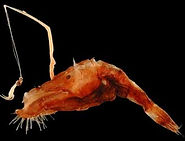
ANGLERFISH 4
(external videos)
Click on the picture for other websites, video's, and pictures.
liveleak.com
Deep Sea Angler Fish
The anglerfish is so called because of its method of predation. This is the fish that goes fishing. It has a long, modified dorsal fin spine sprouting from the middle of its head that ends in a fleshy growth that can move and wiggle to resemble another animal. In some deep sea anglerfish this deadly bait can even emit light (bioluminescence). Passing predators who think they've found an easy meal only need to touch the bait to find out they're the main course. Having been lured inside the anglerfish's wide mouth, the long pointed teeth snap shut and the creature is devoured whole. There are more than 300 species of anglerfish worldwide. They are found in open water and on the sea bed. Some of the bottom dwellers have modified fins that let them walk along the ocean floor.
Scientific name: Lophiiformes
National Geographic
Bony Fish: World's Weirdest: Weird Killer of the Deep
World's Weirdest: Weird Killer of the Deep
The anglerfish uses a shiny lure to bring prey within range of its sharp teeth. But it also has a weirdly clingy side - after finding a female, the male black devil angler latches on and never lets go!
bbc.co.uk
Partner for life
From The Blue Planet
Male angler fish are just a tenth of the size of the females. Their purpose in life is to find a mate somewhere in the darkness. The female releases a scent into the water which the males can detect. Once he's found a female, the male attaches himself permanently to the her with his teeth. Over the next few days the male fuses to the female, her blood circulating around him to keep him alive. The female then benefits from a constant supply of sperm, which would ordinarily be very difficult to find in the vastness of the deep ocean.
bbc.co.uk/nature
First filming of deep sea fish
28 August 2012
A rare species of anglerfish has been filmed for the first time by US scientists.
The deep-dwelling fish, Chaunacops coloratus, was first described in 1899 from a dead specimen but has not previously been seen alive.
In this clip, filmed using a remote-operated vehicle, you can see the fish swimming and lying on the sea bed.
The discovery was made by the team from the Monterey Bay Aquarium Research Institute (MBARI), California, US.
A rare species of anglerfish has been filmed for the first time by US scientists.
The deep-dwelling fish was first described in 1899 from a dead specimen but has not previously been seen alive.
Using a remote-operated vehicle, biologists observed the fish "walking" with its fins and using its namesake lure.
Scientists suggest the footage also shows that the fish change colour as they age.
Continue reading the main story
The discovery is reported in the journal Deep Sea Research Part I by the team from the Monterey Bay Aquarium Research Institute (MBARI), California, US.
They made their discoveries in underwater mountainous areas, known as seamounts, off the coast of California.
The species Chaunacops coloratus belongs to the family of fish known as anglerfish because of their unique method of predation.
In the same way an angler uses a baited line to catch fish, anglerfish dangle a fleshy lump (the esca) from their head on a long filament (the illicium) which lures prey towards their mouth.
"[Our results] reveal a little more information about an animal that lives 3200 metres below the ocean's surface that no one has ever seen before," said Senior Research Technician at MBARI Lonny Lundsten, "and we've got gorgeous HD video of it!"
The study has extended the fish's known depth by 1500m and distribution by a further 5500km north.
"Nobody knew these existed off California or north of Costa Rica for that matter," said Mr Lundsten.
Images were captured by the team's submersible vehicle equipped with scientific instruments and underwater recording equipment.
Blue and red specimens were recorded, as well as those between the two colours
The fish, described as "rarely encountered" by experts, was recorded swimming, retreating from a threat, deploying its lure and "walking" on the sea floor.
According to Mr Lundsten, "walking" is common among anglerfish which use their fins to manouevre across solid surfaces.
Scientists were also intrigued by the observation that smaller fish were steely blue in colour compared to the bright-red adults.
That suggests that colour change is part of the developmental process of the fish as they mature.








